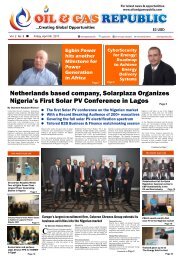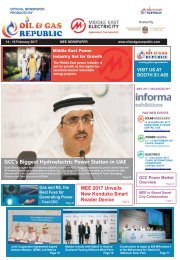OGRepublic August Edition
This edition is focused on Shell Nigeria Exploration and Production Company 'Digital Twin' for its Bonga FPSO.
This edition is focused on Shell Nigeria Exploration and Production Company 'Digital Twin' for its Bonga FPSO.
Create successful ePaper yourself
Turn your PDF publications into a flip-book with our unique Google optimized e-Paper software.
TOP STORY
SNEPCO expanded the project with further
drilling of wells in Bonga Phases 2 and 3 and
through a subsea tie-back that unlocked the
nearby Bonga North West field in August 2014.
Bonga Phase 3 achieved its first oil in October
2015. The Bonga FPSO can produce 225,000
barrels of oil and 150 million standard cubic
feet of gas per day.
In March 2017, SNEPCO commenced the 4th
turnaround maintenance on the Bonga FPSO.
Production from the field was shut down and
resumed the following month.
The company explained that the maintenance
exercise help ensure sustained production and
reduced unscheduled production deferments.
The maintenance involves inspections,
recertification, testing and repair of equipment
as well as engineering upgrades with Nigerian
companies and subsea professionals playing
key roles.
Interestingly, some of the features of an FPSO
digital twin technology includes inspection
capabilities, digital analytics and modelling to
enable monitoring of the asset’s hull structure
during operation without having to rely on
costly routine inspections. DIGITAL TWIN
SAVES COST!
Based on our findings, a digital twin for FPSO is
a virtual replica of the physical FPSO that detect
technical problems, provides and analyze
fatigue in the hull of the FPSO to optimize the
vessel’s structural safety and support riskbased
inspection (RBI).
In a report, DNV GL, a Norwegian company
specialised in assurance and risk management,
has affirmed that the digital twin can be used in
real-time to monitor the FPSO’s condition,
identify and monitor high-risk locations, and
plan cost-efficient maintenance and inspection
accordingly.
A new report shows that the digital twin
technology uses numerical design models and
data from actively recorded strain gauge
sensors onboard the vessel that is said to
provide a full understanding of the
accumulative loading and current state of the
physical FPSO structure.
Francois-Xavier Sireta, technical lead for naval
architecture and principal engineer, DNV GL –
Oil & Gas, said:
“Digital twin can potentially
save millions by avoiding
the costly and possibly
catastrophic repercussions
of ill-informed integrity
management by preempting
and preventing
detrimental damage.
50
SNEPCO’s Digital Twin FPSO
Francois-Xavier
Sireta
“For an asset operating in a harsh environment,
where the loads play an important part in the
possible degradations…, using data from the
site as a basis for optimized inspection
planning, alarms for extreme events, and asset
suitability for life extension is crucial.”
While some experts have said that digital twin
technology can cut offshore decommissioning
costs by 9 - 15%. They noted that it could save
operators millions of dollars on project costs for
platforms ranging from topsides and jacket
removal to subsea infrastructure, facilities ‘deenergizing,
operator costs, onshore recycling
and site remediation and monitoring among
others.
Another report shows that offshore facilities
with topsides of 10,000 - 40,000 metric tons can
benefit from the digital twin to cut
decommissioning costs, and FPSO operations
through to decommissioning phases.
As part of SNEPCO's commitment to enhance
production in the Bonga oil field, the company
deployed a structural digital twin on the Bonga
FPSO in September 2020, during the COVID-19
pandemic.
The digital twin was designed and developed by
Akselos, a Swiss company and creator of the
world’s most advanced engineering simulation
technology, who also provides an engineering
simulation platform based on reduced-basis
finite-element analysis.
The platform is used to create digital twins of
energy infrastructures to improve their design,
maintenance, reliability and lifetime.
Akselos had successfully deployed the Digital
Twin for Shell’s Bonga Main FPSO, located
120km Southwest of the Niger Delta in Nigeria.
The Digital Twin is a physics-based model of the
asset, which represents its entire physical
counterpart in absolute detail and accuracy.
The model is updated with loading conditions
and inspection data regularly, providing the
ability to carry out structural assessments
based on the ‘as is’ condition, from anywhere
and at any time.
The structural Digital Twin, which is based on
Akselos’ patented RB-FEA technology, was
selected by Shell Nigeria Exploration and
Production Company (SNEPCo), Shell’s
deepwater company in Nigeria, because of its
unique ability to realise several operational
objectives. These include the identification of
critical areas for prioritised inspection,
maintenance and repair; a reduction in
personnel onboard the asset; reduced
necessity for physical inspections in hard-toreach
areas such as cargo tanks; and to support
scenario planning for extreme weather events
and asset modification.
The deployment of the breakthrough
simulation technology will also enable safe
asset life extension by replacing the overconservative
estimates made with conventional
s i m u l ation s o f t wa re , w i t h a c c u rate
assessments that reflect actual remaining
fatigue life.
Osagie Okunbor, Country Chair of Shell
Companies in Nigeria commented, "It was a
year when COVID-19 ravaged the global
economy and changed all our lives. I’m proud of
the contribution Shell Companies in Nigeria
OIL AND GAS REPUBLIC I SPECIAL EDITION
DEVELOPED BY:















